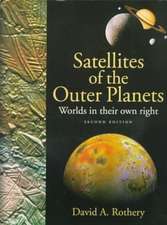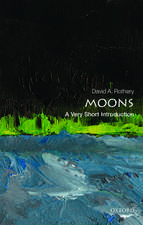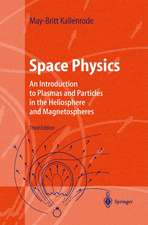Planet Mercury: From Pale Pink Dot to Dynamic World: Springer Praxis Books
Autor David A. Rotheryen Limba Engleză Paperback – 22 sep 2016
There is much about Mercury that we still don’t understand. Accessible to the amateur, but also a handy state-of-the-art digest for students and researchers, the book shows how our knowledge of Mercury developed over the past century of ground-based, fly-by and orbital observations, and looks ahead at the mysteries remaining for future missions to explore.
| Toate formatele și edițiile | Preț | Express |
|---|---|---|
| Paperback (1) | 566.02 lei 6-8 săpt. | |
| Springer International Publishing – 22 sep 2016 | 566.02 lei 6-8 săpt. | |
| Hardback (1) | 635.80 lei 6-8 săpt. | |
| Springer International Publishing – 28 noi 2014 | 635.80 lei 6-8 săpt. |
Din seria Springer Praxis Books
-
 Preț: 294.46 lei
Preț: 294.46 lei -
 Preț: 223.45 lei
Preț: 223.45 lei -
 Preț: 193.12 lei
Preț: 193.12 lei -
 Preț: 167.85 lei
Preț: 167.85 lei -
 Preț: 288.98 lei
Preț: 288.98 lei -
 Preț: 323.74 lei
Preț: 323.74 lei -
 Preț: 401.38 lei
Preț: 401.38 lei -
 Preț: 264.12 lei
Preț: 264.12 lei - 8%
 Preț: 513.00 lei
Preț: 513.00 lei -
 Preț: 190.01 lei
Preț: 190.01 lei -
 Preț: 218.16 lei
Preț: 218.16 lei -
 Preț: 312.06 lei
Preț: 312.06 lei - 17%
 Preț: 414.05 lei
Preț: 414.05 lei -
 Preț: 216.41 lei
Preț: 216.41 lei -
 Preț: 262.27 lei
Preț: 262.27 lei -
 Preț: 264.35 lei
Preț: 264.35 lei -
 Preț: 167.63 lei
Preț: 167.63 lei -
 Preț: 284.81 lei
Preț: 284.81 lei -
 Preț: 259.08 lei
Preț: 259.08 lei -
 Preț: 305.47 lei
Preț: 305.47 lei -
 Preț: 244.14 lei
Preț: 244.14 lei -
 Preț: 227.85 lei
Preț: 227.85 lei -
 Preț: 285.25 lei
Preț: 285.25 lei -
 Preț: 295.56 lei
Preț: 295.56 lei -
 Preț: 357.17 lei
Preț: 357.17 lei -
 Preț: 275.79 lei
Preț: 275.79 lei -
 Preț: 257.08 lei
Preț: 257.08 lei -
 Preț: 349.71 lei
Preț: 349.71 lei -
 Preț: 272.45 lei
Preț: 272.45 lei -
 Preț: 270.27 lei
Preț: 270.27 lei - 8%
 Preț: 456.51 lei
Preț: 456.51 lei -
 Preț: 352.34 lei
Preț: 352.34 lei - 8%
 Preț: 394.80 lei
Preț: 394.80 lei -
 Preț: 320.65 lei
Preț: 320.65 lei -
 Preț: 325.29 lei
Preț: 325.29 lei -
 Preț: 253.11 lei
Preț: 253.11 lei -
 Preț: 192.86 lei
Preț: 192.86 lei -
 Preț: 313.40 lei
Preț: 313.40 lei -
 Preț: 150.51 lei
Preț: 150.51 lei -
 Preț: 233.34 lei
Preț: 233.34 lei -
 Preț: 286.78 lei
Preț: 286.78 lei -
 Preț: 212.01 lei
Preț: 212.01 lei -
 Preț: 366.83 lei
Preț: 366.83 lei -
 Preț: 299.99 lei
Preț: 299.99 lei -
 Preț: 232.27 lei
Preț: 232.27 lei -
 Preț: 284.58 lei
Preț: 284.58 lei -
 Preț: 212.45 lei
Preț: 212.45 lei -
 Preț: 159.81 lei
Preț: 159.81 lei -
 Preț: 349.48 lei
Preț: 349.48 lei - 20%
 Preț: 2061.64 lei
Preț: 2061.64 lei
Preț: 566.02 lei
Preț vechi: 665.91 lei
-15% Nou
Puncte Express: 849
Preț estimativ în valută:
108.31€ • 118.12$ • 91.33£
108.31€ • 118.12$ • 91.33£
Carte tipărită la comandă
Livrare economică 24 aprilie-08 mai
Preluare comenzi: 021 569.72.76
Specificații
ISBN-13: 9783319348940
ISBN-10: 3319348949
Pagini: 193
Ilustrații: XIII, 180 p. 103 illus., 57 illus. in color.
Dimensiuni: 155 x 235 x 11 mm
Greutate: 3.05 kg
Ediția:Softcover reprint of the original 1st ed. 2015
Editura: Springer International Publishing
Colecția Springer
Seria Springer Praxis Books
Locul publicării:Cham, Switzerland
ISBN-10: 3319348949
Pagini: 193
Ilustrații: XIII, 180 p. 103 illus., 57 illus. in color.
Dimensiuni: 155 x 235 x 11 mm
Greutate: 3.05 kg
Ediția:Softcover reprint of the original 1st ed. 2015
Editura: Springer International Publishing
Colecția Springer
Seria Springer Praxis Books
Locul publicării:Cham, Switzerland
Cuprins
A Pale Pink Dot.- Mariner 10.- High time for another mission?.- The surface as seen by MESSENGER.- Magnetosphere and exosphere as seen by MESSENGER.- More questions than answers?.- Appendix.
Recenzii
“The book comprises seven, well-illustrated chapters: the first begin a good summary of pre-space-age knowledge of the planet. … this is a good book and a pleasure to own. It will live where it can be found easily.” (Jeremy Joseph, Geoscientist, Vol. 26, July, 2016)
“Rothery has crafted an engaging and well-constructed book, which is copiously sprinkled with clear illustrations, most of which are in colour. It ought to enjoy a wide readership from the dedicated amateur to the professional specialist. … Very few books devoted to the planet Mercury exist; this latest one is a must for astronomical libraries.” (Richard McKim, The Observatory, Vol. 136 (1250), February, 2016)
“Rothery has crafted an engaging and well-constructed book, which is copiously sprinkled with clear illustrations, most of which are in colour. It ought to enjoy a wide readership from the dedicated amateur to the professional specialist. … Very few books devoted to the planet Mercury exist; this latest one is a must for astronomical libraries.” (Richard McKim, The Observatory, Vol. 136 (1250), February, 2016)
Notă biografică
David A. Rothery is Professor of Planetary Geosciences at the Open University at Milton Keynes, UK. He has been member of the PPARC Solar System Advisory Panel and the BepiColombo Oversight Committee, and is UK Lead Scientist on MIXS (Mercury Imaging X-ray Spectrometer), one of the instruments on the European Space Agency's BepiColombo mission to Mercury to be launched in 2016. His research interests centre on the study of volcanic activity by means of remote sensing, and volcanology and geoscience in general on other planets.
Textul de pe ultima copertă
A new and detailed picture of Mercury is emerging thanks to NASA’s MESSENGER mission that spent four years in orbit about the Sun’s innermost planet. Comprehensively illustrated by close-up images and other data, the author describes Mercury’s landscapes from a geological perspective: from sublimation hollows, to volcanic vents, to lava plains, to giant thrust faults. He considers what its giant core, internal structure and weird composition have to tell us about the formation and evolution of a planet so close to the Sun. This is of special significance in view of the discovery of so many exoplanets in similarly close orbits about their stars. Mercury generates its own magnetic field, like the Earth (but unlike Venus, Mars and the Moon), and the interplay between Mercury’s and the Sun’s magnetic field affects many processes on its surface and in the rich and diverse exosphere of neutral and charged particles surrounding the planet.
There is much about Mercury that we still don’t understand. Accessible to the amateur, but also a handy state-of-the-art digest for students and researchers, the book shows how our knowledge of Mercury developed over the past century of ground-based, fly-by and orbital observations, and looks ahead at the mysteries remaining for future missions to explore.
There is much about Mercury that we still don’t understand. Accessible to the amateur, but also a handy state-of-the-art digest for students and researchers, the book shows how our knowledge of Mercury developed over the past century of ground-based, fly-by and orbital observations, and looks ahead at the mysteries remaining for future missions to explore.
Caracteristici
Describes our state-of-the-art understanding of the planet Mercury based on latest observations, which reveal a very dynamic world Discusses Mercury’s significance in the light of the many exoplanets now known to orbit very close to their stars Explains what we can infer about Mercury's origin and evolution Accessible to amateur astronomers and undergraduate students Includes supplementary material: sn.pub/extras






















